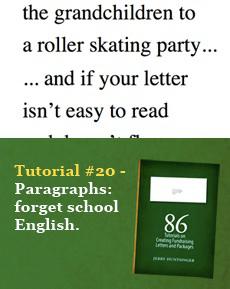Tutorial 20: Paragraphs – forget school English
You were taught in school that a proper paragraph had a beginning, a middle and an end. It was a self-contained idea. And that’s true, when you write a school exam.
- Written by
- Jerry Huntsinger
- Added
- February 09, 2019

But in a letter, a paragraph is only a convenient, visual device for making the copy easy to read. Nothing else. You must break up lines of type, prevent eye fatigue, get the reader involved in the copy.
You can keep the reader involved by using several techniques.
Indentation: a letter with all lines flushed left is difficult to read. You always double space between paragraphs to give the reader’s eye a chance to take a breath. But to get the eye moving with the copy, you must indent, so the reader will stay with you.
Break an idea in the middle of a paragraph. Don’t be afraid to go from idea to idea, and build in little cliffhangers.
And, finally, be careful with full stop punctuations! A full stop brings a thought to an end. And that’s what you want to avoid, except when you want to move on to a new thought. At the very least, when you change thoughts, use either a punctuation connector or a word connector.
Usually you end a paragraph with a full stop, unless, of course, it ends with connecting dots (an ellipsis), a colon, or a question mark. And so, when you begin a new paragraph, use a connector or some technique to keep the reader moving forward.
And here’s the bottom line about all this: when a prospective donor gets your mailing package and does you the courtesy of taking the letter out of the envelope, this reader may be talking over his shoulder to his partner, watching headline news out of the corner of his eye, worrying about why the transmission in the car is jumping out of third gear, or in a hurry to take the grandchildren to a roller skating party...
... and if your letter isn’t easy to read and doesn’t flow quickly from thought to thought; and if the reader has to really concentrate to understand what you are saying, you’ve wasted money for your organisation.
If you think your reader is going to sit down and close his mind to all other distractions and concentrate on the contents of your letter you are living in a fantasy world, and you may never write a successful control package for prospecting.
If you feel uncomfortable in this style of writing, for goodness sake, go and find another job. I hope you won’t need to go that far.
Just loosen up. Write the way you talk. Use grammar and punctuation marks as exciting tools.
© SOFII Foundation 2010-2014.


















